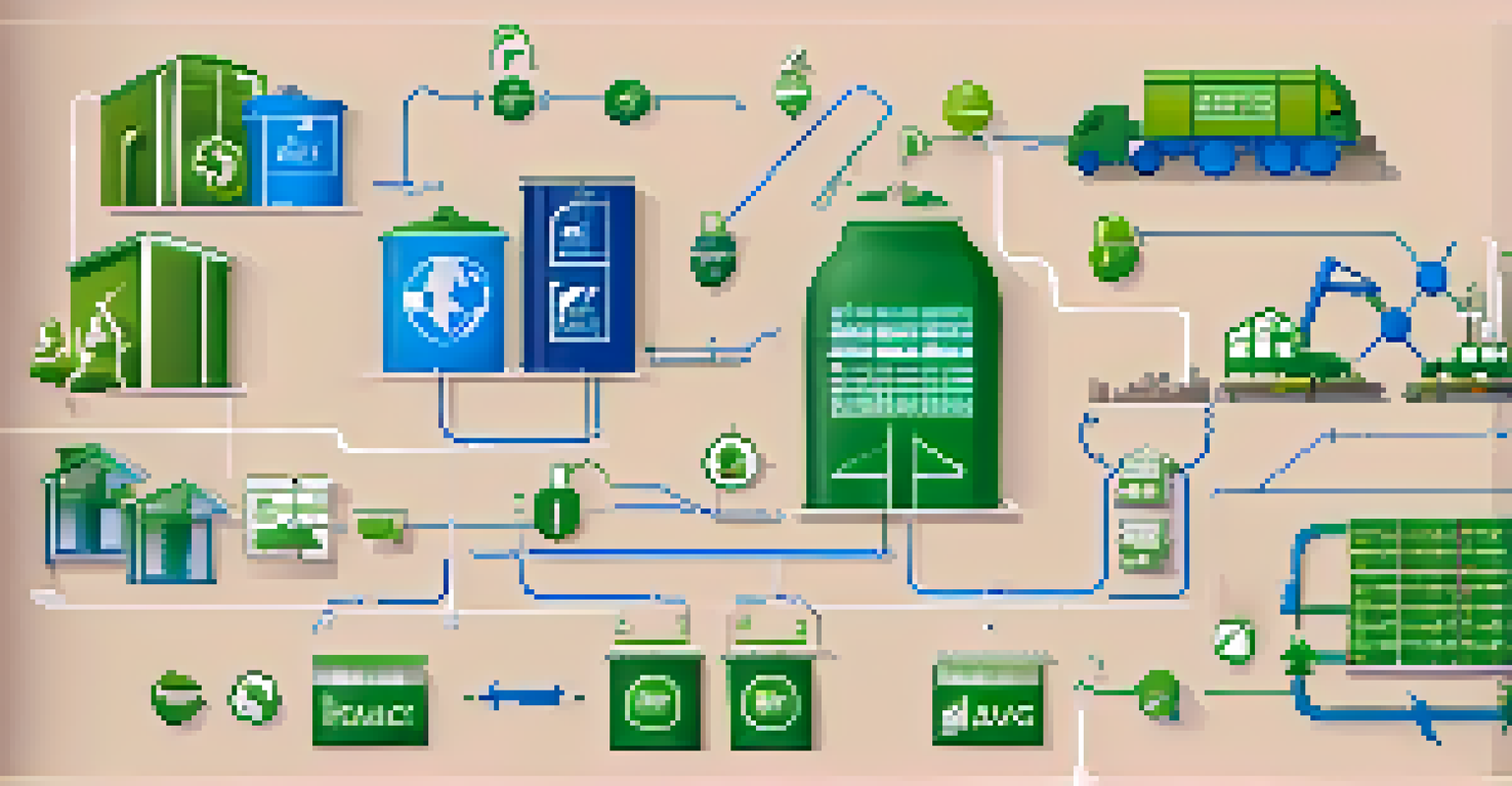Implementing Circular Economy Principles in Business Models

Understanding Circular Economy Principles for Businesses
The circular economy is a transformative approach that focuses on sustainability by minimizing waste and making the most of resources. Unlike the traditional linear economy, which follows a 'take-make-dispose' model, the circular economy emphasizes reusing, recycling, and remanufacturing. This shift not only conserves resources but also creates new business opportunities.
The greatest threat to our planet is the belief that someone else will save it.
For businesses, embracing circular economy principles means rethinking product design and supply chain management. Imagine designing products that can be easily repaired or upgraded, rather than thrown away. This not only enhances customer loyalty but also builds a brand's reputation as a responsible steward of the environment.
Implementing these principles can lead to cost savings and increased efficiency. For instance, using recycled materials can lower production costs while appealing to eco-conscious consumers. As we delve deeper into how to implement these principles, it's essential to understand their practical applications in various business models.
Assessing Your Current Business Model for Circularity
Before making any changes, it’s crucial to evaluate your current business model. Start by analyzing the lifecycle of your products: how they are sourced, manufactured, used, and disposed of. This assessment helps identify areas where waste can be reduced and resources can be reused.

You might consider conducting a SWOT analysis (Strengths, Weaknesses, Opportunities, Threats) focused on sustainability. For example, if your company has excess inventory, this could be an opportunity to explore recycling or repurposing strategies. Understanding your current model will provide a solid foundation for implementing circular principles.
Embrace Circular Economy Principles
Businesses can enhance sustainability by shifting from a linear model to one that focuses on reusing, recycling, and remanufacturing.
Incorporating feedback from stakeholders, including customers and suppliers, can also offer valuable insights. Engaging with these groups will help you identify potential barriers and opportunities for improvement. As you gather this information, you’ll be better equipped to transition towards a more circular approach.
Designing Products with Longevity and Reusability in Mind
Design is at the heart of the circular economy. By creating products that are durable and easy to repair, businesses can significantly extend their lifecycle. Think about the difference between a smartphone designed for easy battery replacement versus one that requires professional assistance to fix.
Waste is a design flaw.
Integrating modular designs is another effective strategy. This allows customers to upgrade components without replacing the entire product. For instance, a modular furniture system lets users adapt their pieces as their needs change, minimizing waste and enhancing user satisfaction.
Moreover, adopting eco-friendly materials can further boost a product's sustainability. By using biodegradable or recycled materials, businesses not only appeal to environmentally conscious consumers but also reduce their overall environmental impact. This approach fosters a culture of sustainability within the company and among its customers.
Creating a Sustainable Supply Chain for Circular Practices
A sustainable supply chain is essential for successfully implementing circular economy principles. This involves collaborating with suppliers who prioritize sustainability in their operations. By building partnerships with responsible suppliers, companies can ensure that their raw materials are sourced ethically and sustainably.
Consider adopting transparent practices throughout the supply chain. Sharing information about sourcing and production processes can enhance accountability and foster trust with consumers. For example, a clothing brand that highlights its use of organic cotton and fair labor practices can differentiate itself in a crowded market.
Design for Longevity and Repair
Creating durable and easily repairable products helps extend their lifecycle and fosters customer loyalty.
Additionally, exploring local sourcing can reduce transportation emissions and support local economies. This not only contributes to a more sustainable supply chain but also strengthens community ties. As you develop your supply chain strategy, remember that it’s about creating a holistic system that supports circularity at every level.
Implementing Take-Back Schemes for Product Lifecycle Management
Take-back schemes are an effective way to promote circularity, allowing businesses to reclaim products at the end of their lifecycle. This not only reduces waste but also provides an opportunity to refurbish or recycle items. For instance, some electronics companies offer discounts on new products when customers return their old devices.
These programs can also foster customer loyalty, as consumers appreciate brands that take responsibility for their products. By offering convenient return processes, businesses can encourage participation and enhance their sustainability efforts. Imagine how much more appealing a brand becomes when customers know they can return their products for recycling or refurbishment.
Furthermore, analyzing the returned products can provide valuable insights into customer preferences and product performance. This data can inform future designs and improvements, ensuring that products continue to meet consumer needs while adhering to sustainable practices. Take-back schemes are not just good for the planet; they can also be a strategic business advantage.
Engaging Stakeholders and Building a Circular Culture
Engaging stakeholders is a crucial step in fostering a circular culture within your organization. This includes not just employees but also customers, suppliers, and the wider community. By involving them in your sustainability journey, you create a sense of ownership and shared responsibility.
Consider hosting workshops or training sessions to educate employees about circular economy principles. This not only empowers them to contribute ideas but also encourages innovative thinking. For example, a company might invite team members to brainstorm ways to reduce waste in their departments, leading to practical solutions that benefit everyone.
Engage Stakeholders for Success
Involving employees, customers, and suppliers in sustainability efforts builds a shared sense of responsibility and drives innovation.
Additionally, transparency in sharing your goals and progress encourages stakeholder support. Regular updates on sustainability initiatives can keep everyone informed and motivated. As you build this culture, remember that it’s about creating a collaborative environment where everyone plays a role in achieving circularity.
Measuring Success and Adjusting Circular Strategies
To ensure the effectiveness of your circular initiatives, it's vital to measure success through key performance indicators (KPIs). These could include metrics related to waste reduction, resource efficiency, and customer engagement. For instance, tracking the amount of material recycled can provide insight into your program's impact.
Regular assessments allow for adjustments to be made in real time. If a particular strategy isn’t yielding the desired results, it’s essential to pivot and explore alternative approaches. This adaptive mindset is crucial in the ever-evolving landscape of sustainability.

Moreover, sharing your successes and challenges with stakeholders can foster a culture of continuous improvement. Transparency encourages collaboration and innovation, enabling everyone to contribute to the journey towards a more sustainable future. Remember, the goal is not just to implement circular practices but to refine and enhance them over time.